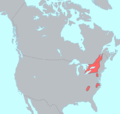A language is head-marking if the grammatical marks showing agreement between different words of a phrase tend to be placed on the heads (or nuclei) of...
7 KB (921 words) - 07:35, 22 March 2024
criterion in language typology in which languages are classified according to whether they are more head-marking or dependent-marking. Many languages employ...
3 KB (433 words) - 12:34, 16 February 2022
common to classify language morphology according to whether a phrase is head-marking or dependent-marking. A given dependency is head-marking, if something...
10 KB (1,394 words) - 02:39, 17 November 2023
linguistics, head directionality is a proposed parameter that classifies languages according to whether they are head-initial (the head of a phrase precedes...
59 KB (7,432 words) - 00:06, 27 January 2024
A zero-marking language is one with no grammatical marks on the dependents or the modifiers or the heads or nuclei that show the relationship between...
3 KB (347 words) - 15:35, 2 September 2023
Dependent-marking language Head-marking language Zero-marking language Nichols, J. 1986. Head-marking and dependent-marking grammar. Language 62, 1, 56-119...
2 KB (248 words) - 09:46, 14 October 2020
not marked.[citation needed] For more information, see Hadza is a head-marking language in both clauses and noun phrases. Word order is flexible; the default...
36 KB (3,611 words) - 05:27, 20 April 2024
consonants. The Iroquoian languages are polysynthetic and head-marking. As of 2020, almost all surviving Iroquoian languages are severely or critically...
14 KB (1,193 words) - 05:39, 15 May 2024
Marker (linguistics) (section Types of marking)
Dependent-marking language Head-marking language Double-marking language Zero-marking language Maddieson, Ian. "Locus of Marking: Whole-Language Typology"...
2 KB (295 words) - 09:39, 29 January 2022
of the first syllable of root). Chamorro is a predicate-initial head-marking language. It has a rich agreement system in the nominal and in the verbal...
43 KB (3,501 words) - 02:09, 16 May 2024
agglutinating, polysynthetic head-marking language, but many of its affixes combine into contractions more like fusional languages. The canonical word order...
20 KB (1,534 words) - 00:14, 25 May 2024
Grammatical case (redirect from Case marking)
example of a language in which case marking occurs on all sub-constituents of the NP; see the following example in which the demonstrative, head, and quantifier...
72 KB (6,638 words) - 11:11, 25 May 2024
Ojibwe language is polysynthetic, exhibiting characteristics of synthesis and a high morpheme-to-word ratio. Ojibwe is a head-marking language in which...
82 KB (8,708 words) - 04:07, 11 May 2024
However, many descendants of fusional languages tend to lose their case marking. In most Romance and Germanic languages, including Modern English (with the...
10 KB (1,091 words) - 18:59, 12 May 2024
tendency in the Paumarí language highlights exactly why languages such as Paumarí are endangered. It is a largely head-marking language with unmarked SVO word...
14 KB (1,963 words) - 03:37, 30 January 2023
Sango Yoruba Auxiliary verb Free morpheme Isolating language Zero-marking language Synthetic language Linguistic typology See pp. 50–51 in Zuckermann, Ghil'ad...
8 KB (875 words) - 06:58, 7 May 2024
Khmer language Thai language Central Flores languages Analytic language Free morpheme Linguistic typology Synthetic language Zero-marking language "A Computerized...
6 KB (600 words) - 19:09, 14 May 2024
Innu-aimun (redirect from Montagnais language)
there is no contrasting short e. Innu-aimun is a polysynthetic, head-marking language with relatively free word order. Its three basic parts of speech...
12 KB (993 words) - 05:59, 27 April 2024
term polysynthetic to languages with high morpheme-to-word ratios, but others use it for languages that are highly head-marking, or those that frequently...
36 KB (4,679 words) - 18:47, 9 November 2023
a heavily dependent-marking language, is an exception to the generalization that the obviative occurs in head-marking languages. Obviation is not overtly...
10 KB (1,116 words) - 23:37, 10 October 2023
the head (or modified noun) and the dependent (or modifier noun). In dependent-marking languages, a dependent genitive noun modifies the head by expressing...
12 KB (1,713 words) - 10:02, 15 April 2024
agglutinative language is a type of synthetic language with morphology that primarily uses agglutination. In an agglutinative language, words contain...
10 KB (1,120 words) - 14:20, 25 May 2024
Active–stative alignment (redirect from Split-S language)
inanimate) Specifically, ergative languages with split case marking are more likely to use ergative rather than accusative marking for NPs lower down the hierarchy...
21 KB (2,472 words) - 06:09, 30 April 2024
opposed to a fusional language, in which affixes may include multiple morphemes). Tzeltal is further classified as a head-marking language, meaning that grammatical...
53 KB (6,444 words) - 23:05, 4 April 2024
sample of the world's languages (one per stock) and tabulates typological characteristics such as: Head-marking vs. dependent-marking Morphological complexity...
4 KB (526 words) - 14:51, 20 March 2023
tense, mood, person, gender, number, and evidential marking. Bulgarian is a fusional inflecting language with some analyticity (including prepositions in...
27 KB (2,940 words) - 11:29, 16 May 2024
Inflection (category Articles containing Scottish Gaelic-language text)
ISBN 0-521-41043-6. (hb); (pbk). Nichols, Johanna (1986). "Head-marking and dependent-marking grammar". Language. 62 (1): 56–119. doi:10.1353/lan.1986.0014. S2CID 144574879...
62 KB (6,153 words) - 04:07, 24 April 2024
realized as voiced fricative sounds [ð, ɣ]. Murrinh-Patha is a head-marking language with a complex verb generally considered to be polysynthetic. The...
17 KB (1,703 words) - 11:11, 29 November 2023
Morphosyntactic alignment (section Locus of marking)
Nichols, J. (1986). Head-marking and dependent-marking grammar. Language, 62(1), 56-119. Comrie, B. (2013). Alignment of Case Marking of Full Noun Phrases...
20 KB (2,334 words) - 00:15, 27 February 2024
Subject–object–verb word order (redirect from SOV language)
in dependent-marking SOV languages, and hence they usually follow the nouns. In most SOV languages with a significant level of head-marking or verb-like...
42 KB (5,537 words) - 03:44, 20 May 2024






